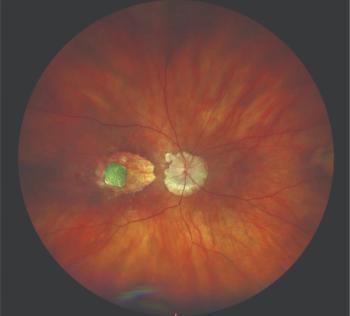
Solution reduces pain after cataract, IOL replacement surgery
Patients treated with Omidria (phenylephrine and ketorolac injection 1%/0.3%, Omeros) reported significantly less early postoperative pain following cataract surgery or IOL exchange than patients treated with placebo and also had significantly lower analgesic use. These findings suggest that use of Omidria could help improve patient satisfaction with these procedures.
Take-home message: Patients treated with Omidria (phenylephrine and ketorolac injection 1%/0.3%, Omeros) reported significantly less early postoperative pain following cataract surgery or IOL exchange than patients treated with placebo and also had significantly lower analgesic use. These findings suggest that use of Omidria could help improve patient satisfaction with these procedures.
By Nancy Groves, Reviewed by Edward Holland, MD
Cincinnati-Omidria (phenylephrine and ketorolac injection 1%/0.3%, Omeros) was associated with significantly less ocular pain than placebo following cataract surgery, in one study. In addition, significantly more patients treated with Omidria were pain free at all timepoints in the first 12 hours after surgery, and fewer Omidria patients reported moderate or severe pain.
Dr. HollandEdward Holland, MD, reported results of an analysis of pooled data from three prospective, randomized controlled studies of Omidria in patients undergoing cataract extraction and replacement or refractive lens exchange surgery. In addition to demonstrating Omidria’s effectiveness vs. placebo at controlling postoperative ocular pain, the analysis suggests that more patients than commonly believed may be experiencing pain.
In this study, nearly 15% of patients treated with placebo reported experiencing moderate to severe pain, while anecdotal evidence suggests that most surgeons would put that figure much lower, Dr. Holland said. He urged doctors to probe more deeply to find out if their patients are truly comfortable or just not speaking up because no one has asked them about pain.
“We all want good visual outcomes, and that’s certainly very important, but the patient perception of the procedure itself, in the first 24 hours, of how much pain they had, also is important. We see patients who see 20/20 the first day but had pain during the surgery or during the night, and they feel that something went wrong,” he explained, adding that this perception may linger well after the procedure is over and pain is gone.
“Anything that we can do to reduce postoperative pain will make the experience better for the patient,” said Dr. Holland, who is director of cornea services, Cincinnati Eye Institute.
Omidria has been approved by the FDA to maintain pupil diameter and reduce postoperative ocular pain during cataract surgery or IOL replacement. While many surgeons are excited about the drug’s ability to prevent intraoperative miosis, the pain data also are compelling, Dr. Holland said.
To evaluate early postoperative pain, he and his coauthors analyzed the data from three studies conducted by Omeros for early postoperative ocular pain and analgesic use. In the earlier studies, patients evaluated their pain using a visual analog scale at 2, 4, 6, 8, and 10 to 12 hours after surgery, and their use of analgesics on the day of surgery was recorded. The analysis included 461 subjects randomly assigned to placebo and 458 randomly assigned to Omidria.
The outcomes showed a highly significant decrease in ocular pain at every timepoint (p=0.0001) in patients treated with Omidria vs. those treated with placebo, Dr. Holland said. Pain also was analyzed by the difference in mean area under the curve cumulative scores between patients treated with Omidria and with placebo; the difference was -4.94 mm (0.77) (p<0.001). Another measure was the number of patients who reported moderate to severe pain at any time during the first 12 hours postoperatively; 14.5% of the placebo group and 7% of the Omidria group reported pain at least once (p=0.0005).
In addition, patients treated with Omidria had significantly lower levels of analgesic use on the day of surgery, 27% vs. 37% for patients treated with placebo (p=0.0019).
Edward Holland, MD
Dr. Holland presented this study at the American Society of Cataract and Refractive Surgery 2015 Symposium and Congress in San Diego. He is a consultant for Omeros.
Newsletter
Don’t miss out—get Ophthalmology Times updates on the latest clinical advancements and expert interviews, straight to your inbox.





